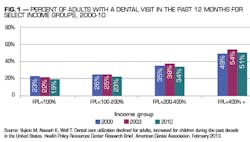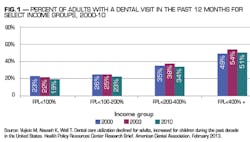More children seeing the dentist
by Marko Vujicic, PhD
Oral health is an important component of general health and routine, and preventive dental care has been associated with increased savings to the health care system. But dental care utilization patterns are changing in the United States. In a series of publications from the ADA's Health Policy Resources Center, my team looked at national and state utilization patterns over the past decade, using the most reliable data available.
We made some important discoveries. We found that the pattern of dental care utilization during the 2000s was very different for adults and children. The percent of adults with a dental visit in the last 12 months decreased from a peak of 41% in 2003 to 37% in 2010. For children, the percent with a dental visit in the last 12 months increased from 42% in 2000 to 46% in 2003, and roughly held steady through 2010. An important finding is that dental care utilization among adults started to decline in 2003, well before the start of the recent economic downturn. More than the recession is at play here.
Another key finding is that adult dental care utilization declined most among the poor, but all income groups were affected (Fig. 1). Utilization declined for middle income adults from 38% in 2003 to 34% in 2010, and for higher income adults from 54% in 2003 to 51% in 2010. This is clearly not just a low-income adult issue.
As a result, the gap in dental care utilization between adults in low-income and high-income households increased by six percentage points during the 2000s. In a separate analysis, we show that the national trends occurred in most states. In fact, dental care utilization among low-income children increased during the 2000s in all but three states, which is a remarkable achievement. For low-income adults, utilization decreased in the majority of states, with Massachusetts and Virginia being notable exceptions. Research we are now completing shows that the main drivers of the decline in adult utilization are decreases in private dental benefits, stagnating household income, and population demographic shifts.
The decline in dental care utilization among adults warrants significant attention. The evidence suggests that increased financial barriers to dental care are growing among adults. The Affordable Care Act will do little to reverse this, as adult dental benefits are not mandated. Expanding access to dental care for adults, particularly low-income adults, will be a significant policy challenge in the coming years.
To access the full Research Briefs, visit http://www.ada.org/1442.aspx
Marko Vujicic, PhD, is Managing Vice President, Health Policy Resources Center at the American Dental Association, where he is responsible for overseeing all of the Association's policy research activities. Prior to joining the American Dental Association, he was Senior Economist with The World Bank in Washington D.C., where he directed the global health workforce policy program. You may reach him at [email protected].
Past DE Issues

